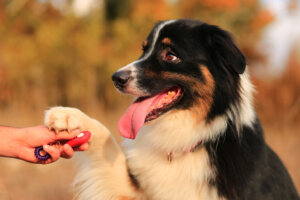Can Dogs Distinguish Between Different Languages?

The University of Eötvös in Budapest recently conducted some research into whether dogs distinguish between different languages, and they concluded that yes, they do!
It’s the first evidence that a non-human is able to detect variation in language. So, how can dogs distinguish between several languages? We’ll show you in the following article!
Can dogs distinguish between different languages?
In the study we mentioned above, the researchers were able to scan the dogs’ brains. They did this while playing a little with them and talking to them in Hungarian or Spanish.
Out of all dogs in the research project, two of them came from homes where they were only spoken to in Spanish. And the remaining 16 came from families where they communicated in Hungarian.
The text read to the dogs
Part of the experiment consisted of reading to them an extract from the work “The Little Prince” by Antoine de Saint-Exupéry in both Hungarian and Spanish. They were then able to listen to recordings that didn’t make any particular sense.
Thanks to the scanning, it was discovered that the auditory regions in the canines’ brains were activated when they heard the language that was familiar to them. This was even the case when they were spoken to in gibberish, even if this was in another language. The dogs could then distinguish between different languages. One more sign of the excellent communication between dogs and humans.
This is a landmark finding, as it’s the first time that a non-human brain has been proven to be able to differentiate different languages.

Why are dogs able to distinguish languages?
The researcher who led the study, Attila Andics, said that “possibly brain changes from the tens of thousands of years that dogs have been living with humans have made them better language listeners, but this isn’t necessarily the case. Future research will have to figure this out.”
Dogs perceive the auditory regularities of the language they’re exposed to.
What was most remarkable was that the older and more adult the dog was, the better it was able to distinguish in its brain the reaction to familiar and unfamiliar language.
Dr. Raúl Fernández-Pérez, the co-author of the paper, commented that “each language is characterized by a variety of auditory regularities. Our findings suggest that during their life with humans, dogs perceive the auditory regularities of the language they are exposed to.”
Do other species have the same ability to pick up languages?
This study opens the doors of neurological research towards other species. The results of advances in this field are eagerly awaited in the development of artificial intelligence.
So, it isn’t surprising that the authors are considering extending their studies. As they have stated, “It’s exciting, because we discovered that the ability to learn about the structures and tone of a language isn’t only human. Even so, we don’t know if this ability is unique to dogs or if it’s general among non-human species.”

Your dog understands when you speak to them
The conclusions of this study, published in the specialized journal Neuroimage, have reaffirmed what we already suspected. And it’s no small thing.
The dogs that live in our home pick up on every inflection in our voice, every change in tone. Theyunderstand us much better than we do ourselves.
This is because their social skills are an advantage as a species close to humans. They understand the environment they live in better by relating well to humans.
By being interested in their environment and in their human, they tune in and synchronize their senses and adapt their way of communicating with their owner.
This has probably been one of the main reasons to become man’s ally and best friend, and was the main reason for its domestication 12,000 years ago.
The University of Eötvös in Budapest recently conducted some research into whether dogs distinguish between different languages, and they concluded that yes, they do!
It’s the first evidence that a non-human is able to detect variation in language. So, how can dogs distinguish between several languages? We’ll show you in the following article!
Can dogs distinguish between different languages?
In the study we mentioned above, the researchers were able to scan the dogs’ brains. They did this while playing a little with them and talking to them in Hungarian or Spanish.
Out of all dogs in the research project, two of them came from homes where they were only spoken to in Spanish. And the remaining 16 came from families where they communicated in Hungarian.
The text read to the dogs
Part of the experiment consisted of reading to them an extract from the work “The Little Prince” by Antoine de Saint-Exupéry in both Hungarian and Spanish. They were then able to listen to recordings that didn’t make any particular sense.
Thanks to the scanning, it was discovered that the auditory regions in the canines’ brains were activated when they heard the language that was familiar to them. This was even the case when they were spoken to in gibberish, even if this was in another language. The dogs could then distinguish between different languages. One more sign of the excellent communication between dogs and humans.
This is a landmark finding, as it’s the first time that a non-human brain has been proven to be able to differentiate different languages.

Why are dogs able to distinguish languages?
The researcher who led the study, Attila Andics, said that “possibly brain changes from the tens of thousands of years that dogs have been living with humans have made them better language listeners, but this isn’t necessarily the case. Future research will have to figure this out.”
Dogs perceive the auditory regularities of the language they’re exposed to.
What was most remarkable was that the older and more adult the dog was, the better it was able to distinguish in its brain the reaction to familiar and unfamiliar language.
Dr. Raúl Fernández-Pérez, the co-author of the paper, commented that “each language is characterized by a variety of auditory regularities. Our findings suggest that during their life with humans, dogs perceive the auditory regularities of the language they are exposed to.”
Do other species have the same ability to pick up languages?
This study opens the doors of neurological research towards other species. The results of advances in this field are eagerly awaited in the development of artificial intelligence.
So, it isn’t surprising that the authors are considering extending their studies. As they have stated, “It’s exciting, because we discovered that the ability to learn about the structures and tone of a language isn’t only human. Even so, we don’t know if this ability is unique to dogs or if it’s general among non-human species.”

Your dog understands when you speak to them
The conclusions of this study, published in the specialized journal Neuroimage, have reaffirmed what we already suspected. And it’s no small thing.
The dogs that live in our home pick up on every inflection in our voice, every change in tone. Theyunderstand us much better than we do ourselves.
This is because their social skills are an advantage as a species close to humans. They understand the environment they live in better by relating well to humans.
By being interested in their environment and in their human, they tune in and synchronize their senses and adapt their way of communicating with their owner.
This has probably been one of the main reasons to become man’s ally and best friend, and was the main reason for its domestication 12,000 years ago.
All cited sources were thoroughly reviewed by our team to ensure their quality, reliability, currency, and validity. The bibliography of this article was considered reliable and of academic or scientific accuracy.
Referencia: “Speech naturalness detection and language representation in the dog brain” by Laura V. Cuaya, Raúl Hernández-Pérez, Marianna Boros, Andrea Deme, and Attila Andics, 12 December 2021, NeuroImage 2021.
DOI: 10.1016/j.neuroimage.2021.118811
This text is provided for informational purposes only and does not replace consultation with a professional. If in doubt, consult your specialist.








